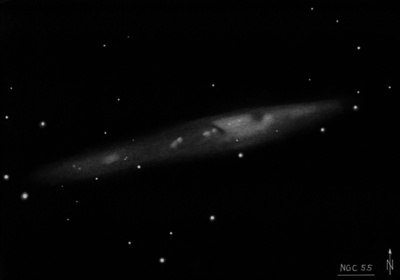
15x50 IS binoculars (10/21/06): although very low in the southern sky, visible as a faint, relatively large elongated patch using handheld IS binoculars. Easy to locate 3.8° NW of Alpha Phe as the galaxy is exactly collinear with three mag 7 stars to the east that are aligned east to west.
James Dunlop discovered NGC 55 = D 507 = h2315 on 7 Jul 1826 from Parramatta, New South Wales. Using his 9-inch f/12 speculum reflector, he described it as "a beautiful long nebula, about 25' in length; position N.p. and S.f., a little brighter towards the middle, but extremely faint and diluted to the extremities. I see several minute points or stars in it, as it were through the nebula: the nebulous matter of the south extremity is extremely rare, and of a delicate bluish hue. This is a beautiful object." Dunlop observed the galaxy on 4 nights and made a simple sketch (Figure 21).
John Herschel first observed this galaxy from the Cape on 3 May 1834: "bright; very large; very much elongated in a long irregular train, the preceding end being much the brightest. Whole length = 1.5 diam. of field, or 22' The nucleus is either a double star or a much more sharply terminated nebulous mass, elongated in a different position (146.5 ) from that of the nebula (109.8 )." He observed it again on 23 October 1835, recording it as "very bright; very large; very much elongated; at least 25' long and 3' broad. The following part is faint, the preceding and shorter trinuclear the 2d, nucleus taken. A strange object." His final observation on 4 October 1836 reads: "very bright, very large; a very long irregular crooked ray with 3 nuclei, the second of which appears to consist of stars." His sketch of the galaxy (fig. 8, plate IV) clearly shows its convoluted form and three brighter sections. In his discussion, he grouped it together with the galaxy NGC 300 and the star cluster NGC 1950 as "nebulae of irregular forms having a tendency to several centres of condensation; in the case of NGC 1950] but little conspicuous - in that of [NGC 55] (otherwise remarkable for its extravagant length and crooked shape) much more so, while in NGC 300], the formation of separate nuclei is decided, the intermediate faint nebula barely sufficing to mark them as forming a connected system."
Joseph Turner sketched NGC 55 using the 48" Great Melbourne Telescope on 29 Oct 1875 (plate I, figure 2 in "Observations of the Southern Nebulae made with the Great Melbourne Telescope from 1869 to 1885"). He reported "The present appearance agrees well with H.'s description and drawing. The 'following' portion is now much fainter than shown by H.'s sketch; indeed it is so very faint that its exact outlines cannot with certainty be determined, a faint whitishness being all that can be made out, while the star-like appearance described by H. in his portion cannot now be seen. The 'preceding' portion is still, as shown by H., much the brightest. There are still three nuclei, the centre one of which is much the brightest. H. says this one appears to consist of stars; but although I have tried several powers, I cannot with any certainty, determine this point, although it has, at times, a sparkling appearance. The 'following' portion of this nebula appears to have become much fainter since H. observed it." Turner's sketch shows the bright knot on the eastern end of the galaxy.
Sw. XI-2 (later IC 1537), found by Swift on 23 Sep 1897 and described as "eeeF; vL; eE; close f NGC 55; f of 2." is actually the ESE arm of NGC 55, which was sketched by both Dunlop and John Herschel (plate IV, #8).
200/250mm - 8" (9/25/81): very large, very elongated, brighter to the west, very faint eastern section.
300/350mm - 13.1" (11/5/83): fairly bright. The very faint eastern portion is near detached from the bright WNW section.
400/500mm - 17.5" (11/1/86): very large, edge-on 6:1 WNW-ESE, 16'x3'. Very asymmetric with a bright, elongated western portion, darker center and a faint eastern section (IC 1537). Faint stars are involved at the west side. The eastern portion appears tilted at a slight angle to the main western portion.
600/800mm - 30" (11/4/10 - Coonabarabran): NGC 55 nearly filled the 37' field of the 21mm Ethos at 264x, extending close to 30' in length WNW-ESE and roughly 4' in width. The structure was fascinating at 429x with a highly irregular surface brightness due to dusty patches and rifts, along with bright clumps and knots. The "bright" central section, which is offset WNW of center, spans ~9' in length. At the west end of the central section, the surface brightness dims significantly and the galaxy tapers, extending several arc minutes further WNW. At the ESE side of the central portion is a bright, elongated, mottled core, roughly 1' in length and slightly bulging. Just ESE of the core are two noticeable knots; the first is small but elongated, the second knot is very bright and elongated. With careful viewing the second knot resolved into two individual pieces or clumps. Continuing further ESE, the surface brightness drops significantly very quickly and a large, elongated dark notch appears to take a bite out of the galaxy. Just as the galaxy begins to brighten again towards the ESE end, there is another bright round knot and a second very small piece just detached to the ENE. At the ESE tip the galaxy brightens a bit more and has an irregular, patchy appearance with a couple of brighter stars superimposed.
Notes by Steve Gottlieb